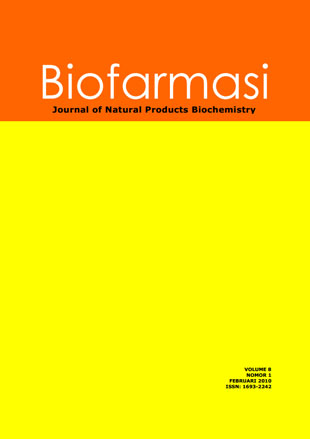Extraction and characterization of pectin on green cincau (Premna oblongifolia) in edible film production
##plugins.themes.bootstrap3.article.main##
Abstract
Rachmawati AK, Anandito RBK, Manuhara GJ. 2010. Extraction and characterization of pectin on green cincau (Premna oblongifolia) in edible film production. Biofarmasi 8: 1-10. The use of green cincau pectin was presumed to influence the result of edible film characteristics, i.e. thickness, solvability, elongation, tensile strength, and water vapour transmission (WVTR). The aims in this research were: (i) to find out the chemical characteristics of green cincau pectin on the physical (thickness and solvability) and mechanical properties (elongation and tensile strength), (ii) to determine the edible film inhibition of green cincau pectin against the water vapour transmission rate, and (iii) to find out the edible film capability in inhibiting the weight loss on green grape by wrapping and coating method. The five major steps in this research were material preparation (making green cincau powder and pectin extraction), the characterization of extraction result pectin, making edible film, edible film characterization, and edible film application. This research used a completely randomized design with twice replications in edible film making for each treatment concentration and twice replication for edible film characteristic testing in each edible film making replication. Variance analysis was used to analyze data, if there was a significant difference, it will be continued with a Duncan Multiple Range Test at a significance level of 0.05. The yield of green cincau powder and pectin were 27.5% and 15.2%, respectively. The extraction result pectin consisted of 5.09% water, 11.06% protein, 0.35% fat, 28.5% ash, 55.00% carbohydrate (by different), and 12.15% crude fiber. The increasing of pectin concentration tends to increase the thickness and tensile strength, but reduced the water vapour transmission rate. The lowest water vapour transmission rate occurred at the edible film with 30% pectin concentration. Its water vapour transmission rate was 0.317 g.mm/m2.hour. The green grape weight loss with a wrapping method was 0.0212 g/hour, and the green grape weight loss with a coating method was 0.0634 g/hour.
